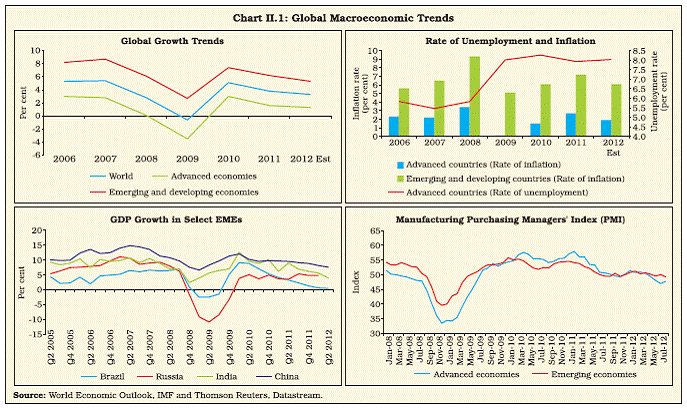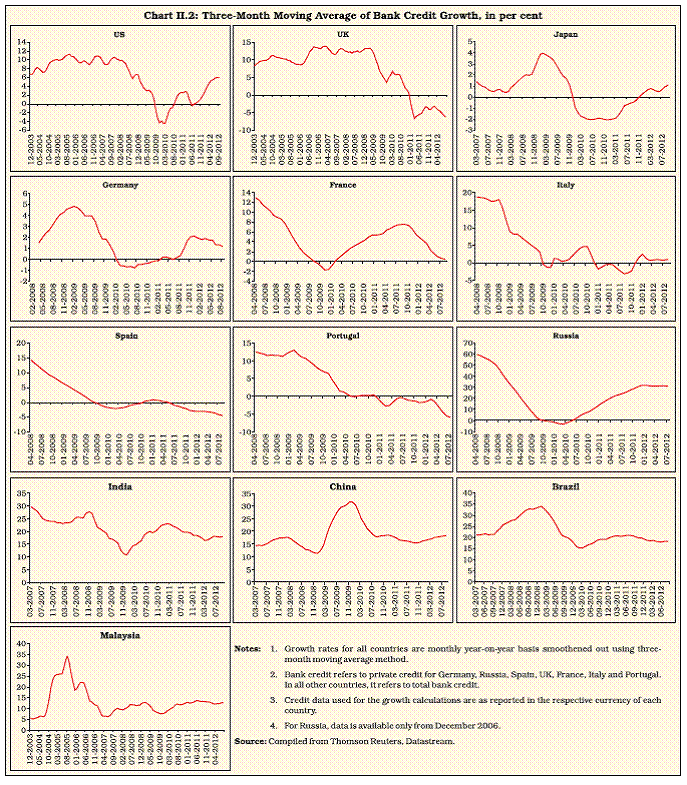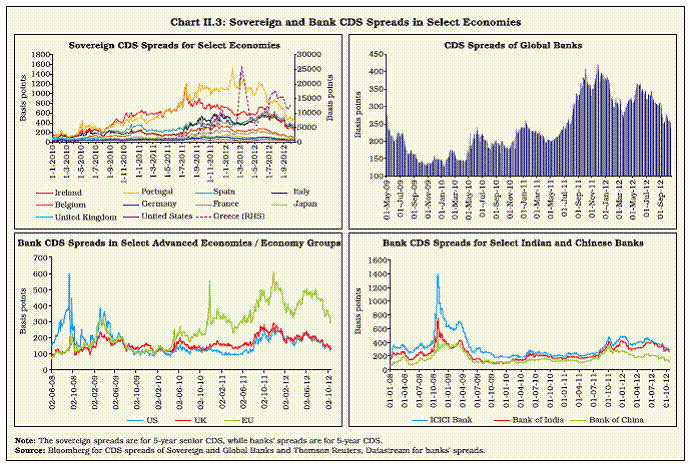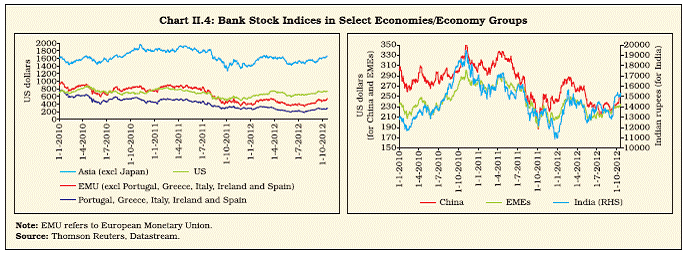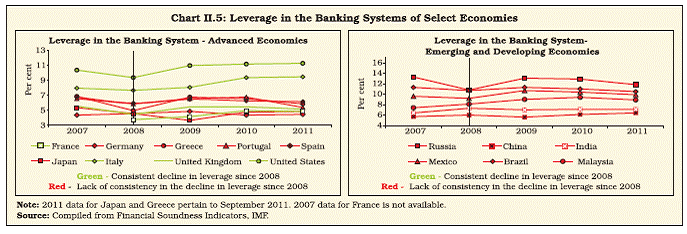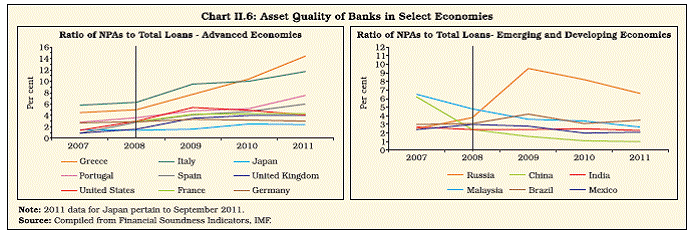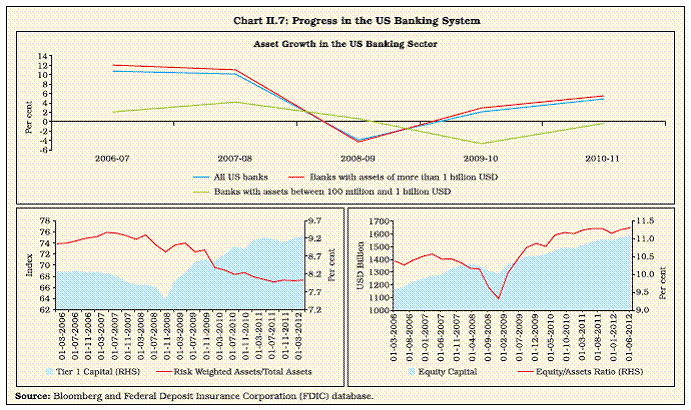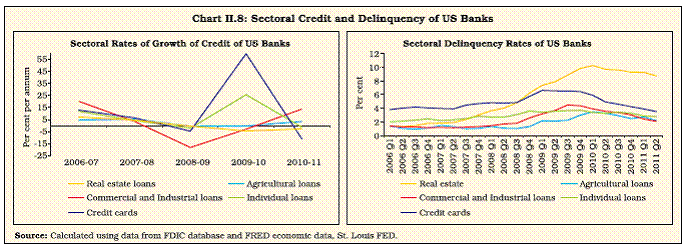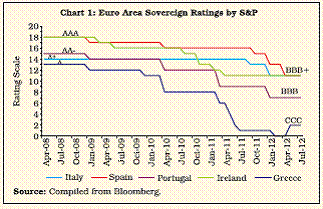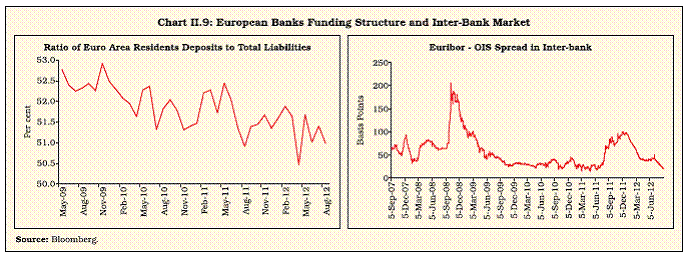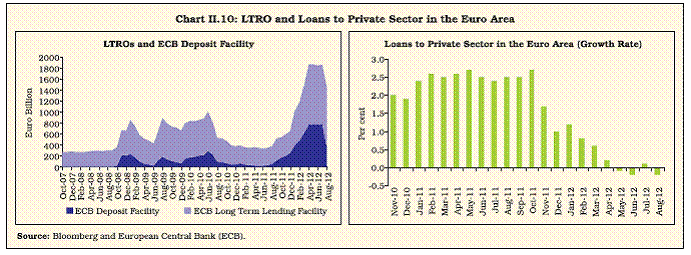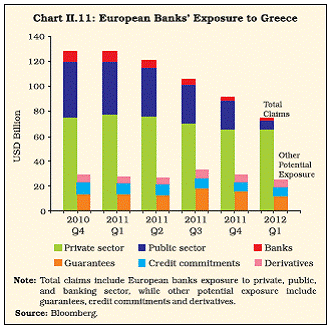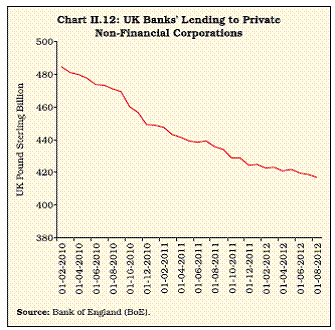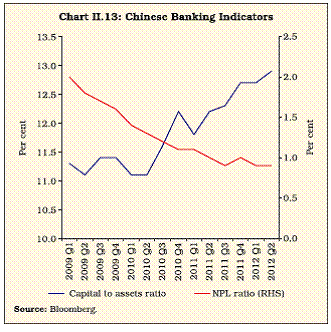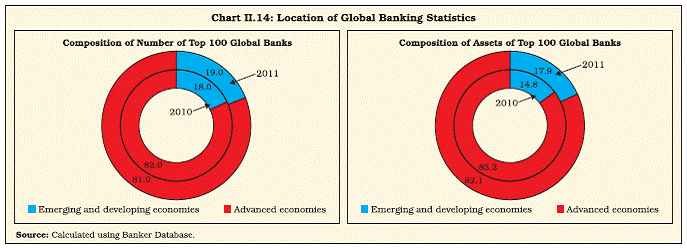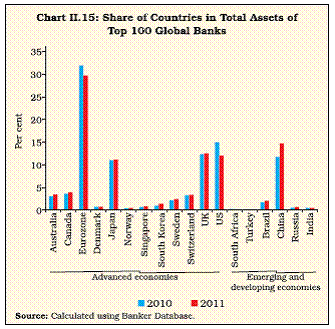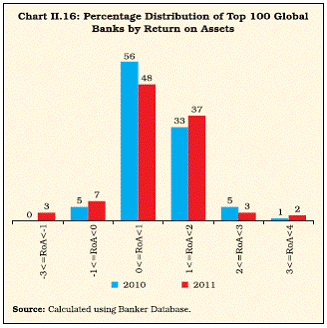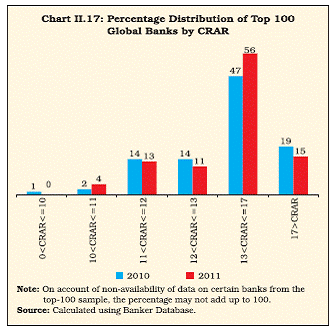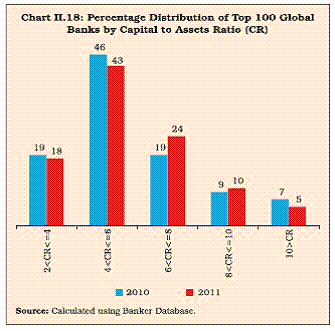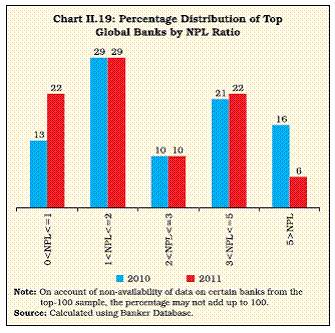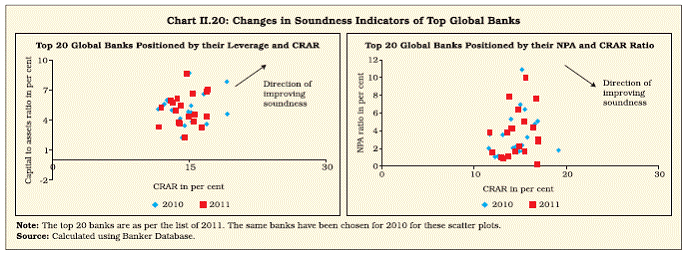Global Banking Developments - ربی - Reserve Bank of India
Global Banking Developments
The global banking system was affected by the weakening of global growth, escalation of the sovereign debt crisis and financial market stress. While US banks have been able to reduce their leverage and reliance on wholesale funding, European banks’ dependence on wholesale funding remains high. The fundamentals of the banking sector in emerging economies were better, reflecting higher economic growth and relative balance sheet strength on the back of higher domestic funding and sound capital base. Significant progress has been made on the regulatory front, such as Basel III, SIFIs and shadow banking, but implementation challenges remain. Many advanced countries have made substantial progress in putting in place effective resolution regimes and bail-in mechanisms. The European Union and European Central Bank (ECB) have undertaken various measures to address funding and deleveraging risks, but concerns remain. In the long term, banks should focus on cost reduction strategies and work towards restoring investor confidence. 1. Introduction 2.1 The global banking system in 2011 and 2012, so far, witnessed severe setbacks as it continued to be affected by tepid recovery in global growth; the re-emergence of the euro area sovereign debt crisis; and funding and deleveraging risks for global banks. Uncertainties emanating from the ongoing euro area sovereign debt crisis, the downgrade in the outlook of several advanced economies (AEs), and stability issues of euro area banks amidst bank recapitalisation concerns, among other factors, kept international financial markets and the banking system volatile during most of 2011-12. 2.2 Global credit growth demonstrated a mixed picture: in emerging market economies it was sustained, in the US it showed some revival; but in Europe it decelerated. The return on assets (RoA) improved for banks in the US and some EMEs, but declined in European countries. The banking trends in select regions and countries show that the US banking system has made substantial progress in repairing balance sheets and enhancing capital. In the euro zone banking system, the risks remain at an elevated level on account of the vicious circle between banks and sovereigns. The crisis in the euro area has affected the UK financial system also and the funding costs for banks have risen sharply, leading to higher interest rates and lower credit availability for household and corporate borrowers in the UK. 2.3 An analysis of the performance of the top 100 global banks shows that the share of emerging economies in global banking continued to increase. Among emerging and developing countries, Chinese banks have registered substantial gains in the top 100 bank ratings. On the global policy reforms front, there has been some progress in rule framework for the Basel Rule, systemically important financial institutions (SIFIs), shadow banking, resolution regimes and bail-in mechanisms. Global growth remains considerably weak 2.4 The global economy suffered a major setback in late 2011 as concerns about financial stability in the euro area came to the fore. Market stress spread throughout the euro area and bond yields soared in peripheral economies as investors were increasingly concerned about the risk of a sovereign default. These developments dramatically highlighted the risk of adverse, self-fulfilling shifts in market sentiment that could rapidly push fragile sovereigns into a bad equilibrium of rising yields, a funding squeeze for domestic banks, and a worsening economy [IMF’s Global Financial Stability Report (GFSR) – April 2012]. 2.5 Global growth moderated to 3.8 per cent in 2011 compared with 5.1 per cent achieved in 2010 (Chart II.1). The slow growth was mainly driven by weakening growth in the advanced economies. On the other hand, emerging market economies continued to grow at a higher rate. For the year 2012, various forecasts have suggested the continuation of sluggish global growth. The IMF’s World Economic Outlook (WEO) – October 2012 has projected global growth to moderate to 3.3 per cent in 2012 with significant downward risks. 2.6 Against this global macroeconomic setting, Section 2 reviews the performance of the global banking system using major indicators of banking activity and soundness for select advanced and emerging economies. Section 3 looks into the detailed individual performance of the banking systems in few advanced and emerging economies/ economy groups. Section 4 analyses the performance of the top-100 banks having major global presence. Section 5 highlights the major regulatory and supervisory policy initiatives with regard to the global banking system during the year. Section 6 presents the overall assessment and outlook for the global banking sector for 2013. 2. Global Banking Trends 2.7 The recent financial crisis brought to the fore the weaknesses in the global banking industry, which, in turn, was manifested in dwindling public confidence in the banking industry. The recent financial crisis has led to a realisation of the inadequacies in the banking sector. Banks had failed to secure stable and diversified sources of income and to contain costs, which resulted in liquidity stress for the institutions. Secondly, opaque balance sheets significantly impaired analysis of risk, thus preventing timely awareness of the weakness of banks’ capital buffers (BIS Annual Report – 2011-12).
Divergence in the credit growth across regions 2.8 Mirroring the divergence in the growth performance of economies, the credit growth across economies demonstrated an uneven pattern (Chart II.2).
Return on assets showed a declining trend in general 2.9 The return on assets (RoA), an indicator of the banking system’s profitability, showed a divergent trend across economies. In general, it witnessed a declining trend (Table II.1). Financial stress continued to be at an elevated level 2.10 In late 2011, concerns about the sustainability of fiscal deficit in the advanced countries, especially in euro area countries, reescalated. The heightened risk perception by the markets resulted in the widening of the credit default swap (CDS) spread of the sovereign bonds of the affected economies in the euro area. The banking industry came under severe funding stress, as indicated by the rising CDS spreads for global banks (Chart II.3). The funding of the EME banks was relatively unaffected due to their limited reliance on wholesale deposits for funding. The financial stress reduced following the measures taken by advanced economies.
Contagion spreads to bank stocks 2.11 Bank stocks, particularly in the advanced economies, declined sharply, reflecting the downgrade of sovereign debt of some countries for most part of 2011 and 2012 (Chart II.4). Further, the uncovering of serious allegations regarding money laundering and trading losses by a few banks has dented market confidence in the global banking system. Banking stocks in the EMEs declined reflecting the risk aversion arising from the euro area sovereign debt crisis and inflationary concerns in some EMEs. The recent LIBOR controversy has drawn the world’s attention to how a few large global financial institutions allegedly manipulated one of the most commonly used market rates (Box II.1). Decline in international banking business 2.12 During 2011-12, the international banking business (by location of reporting banks) witnessed a contraction. This is in contrast to the revival in international business between 2009-10 and 2010-11 (Table II.2). The contraction in the flow of cross-border credit was due to banks’ efforts to strengthen their capital base. The reduction was especially marked for cross-border claims on the euro area. Financial Soundness of Banks Capital adequacy levels vary across countries 2.13 Intensified efforts by the banks to strengthen their capital position reflected in an increase in the level of capital adequacy in several economies. However, few European countries and EMEs exhibited a decline in their capital adequacy levels (Table II.3). Uneven decline in leverage 2.14 An analysis of the leverage ratio as measured by the percentage of total capital (and reserves) to total assets across countries reveals an uneven pattern in deleveraging by the banking sector (Chart II.5). Improvement in asset quality 2.15 Globally, there was an improvement in the asset quality of banks in 2011, except in the crisisridden euro area countries (Chart II.6). Among EMEs, most of the economies showed considerable improvement in asset quality in the years following the crisis.
Box II.1: Issues in LIBOR Fixation and Implications for Banks The recent London Interbank Offered Rate (LIBOR) fixing incident has added further uncertainty to the fragile financial markets. The incident brought to the fore the flaws in the methodology underlying the computation of LIBOR, one of the most commonly used market rates, which lent itself to manipulation by certain key players. LIBOR is a benchmark used by banks, securities houses and investors to gauge the cost of unsecured borrowing in the London interbank market. Its significance as a benchmark has risen since its introduction in the 1980s, because it acts as a reference rate for the majority of financial products, such as, interest rate swaps, corporate loans, and residential mortgages. The LIBOR is published by the British Bankers’ Association (BBA) and is calculated each day by Thomson Reuters, to whom major banks submit their cost of borrowing unsecured funds for 15 periods of time in 10 currencies. The highest and lowest submissions are discarded and the average of the remaining submissions is taken to compute LIBOR for the given day. Since LIBOR is not derived from real rates but is based on the submissions of the 18 largest international banks on their estimates of the levels at which they could borrow from other banks, banks could influence the LIBOR benchmark. The bankers attempted to engineer the benchmark rate by nudging their own firms’ submissions up or down in small increments to benefit their trading books during the period 2005 to 2008. The banks lowered their rate submissions to provide a healthier picture of their finances particularly at the height of the financial crisis during 2008 to 2009. The incident has brought into focus the need for regulatory reforms in the fixation of LIBOR benchmarks. The UK Government requested the Financial Services Authority (FSA) to review the framework for the setting of LIBOR led by Martin Wheatley, its Managing Director. The Terms of Reference for the Committee included: (i) necessary reforms in the current framework for setting and governing LIBOR; (ii) the adequacy and scope of sanctions to appropriately tackle LIBOR manipulation; and (iii) whether analysis of the failings of LIBOR has implications on other global benchmarks. The Wheatley Committee had placed an initial discussion paper to solicit public feedback on August 10, 2012. Based on the public feedback, the Committee submitted its final report on September 28, 2012. The Committee has recommended a ten-point plan for comprehensive reform for LIBOR, which has been accepted by the UK Government. The major reforms include (i) administering LIBOR, and submitting to LIBOR, become regulated activities under the Financial Services and Markets Act, 2000 (Regulated Activities) Order 2001, (ii) The BBA should transfer responsibility for LIBOR to a new administrator, (iii) Submitting banks should make explicit and clear use of transaction data to corroborate their submissions, (iv) The BBA, and in due course, the new Administrator, should cease the compilation and publication of LIBOR for those currencies and tenors for which there is insufficient trade data. This will result in decline of number of published rates from 150 to 20. The controversy has added further uncertainty to the global financial system and reduced market confidence in key benchmark rates as well as in the banking system. The bank stocks of some of the allegedly involved banks have declined following the LIBOR fixation incident. The banking institutions involved in the incident could face stringent fines and penalties, as a large number of lawsuits have already been filed against these companies. This may hamper the banks’ efforts to strengthen their balance sheet. The incident also brought forth wider debate over how other benchmark rates and indices are calculated. Some benchmarks are already under scrutiny; the International Organisation of Securities Commissions (IOSCO) is investigating oil spot prices, while the European Commission is looking into other financial benchmarks, such as the Euro Interbank Offered Rate (EURIBOR). References: BBA website <www.bbalibor.com>. U.K. Government (2012), The Wheatley Review of Libor: Initial Discussion Paper, London, August. U.K. Government (2012), The Wheatley Review of Libor: Final Report, London, September. Wallace, P. (2012), Trading-Libor - How Do You Solve a Problem Like Libor?, The Banker 3. Banking Trends in Select Regions and Countries US banking system – substantial progress in repairing balance sheets and enhancing capital 2.16 The US banking system has made considerable progress towards repairing balance sheets and building capital since the recent financial crisis. Large US banks have reduced their reliance on short-term wholesale funding. The banks have reduced impaired assets through charge-offs, write-downs and asset disposals and increased the Tier-1 capital. Concomitantly, the banks’ equity capital and equity assets ratio has seen an improvement (Chart II.7).
The Stress Tests for US banks show improved resilience 2.17 The stress tests conducted under the Comprehensive Capital Analysis and Review (CCAR) in March 2012 show that most of the 19 banking firms would have sufficient capital to withstand a period of intense economic and financial stress and still be able to sustain their lending capacity. Improvement in the credit quality of US banks 2.18 There has been significant growth in credit to the industrial sector, but credit to real estate and individual loans remains muted. The overall delinquency rates on loan portfolios have fallen, but given the wide difference across sectors in terms of asset quality, concerns remain (Chart II.8).
Euro area banking system – risks remain at an elevated level 2.19 The current euro area debt crisis has highlighted the existence of a vicious circle between banks and sovereigns (Box II.2). Their increasing inter-linkage has led to a prolonged collapse of market confidence in the European Union (EU) banking sector, affecting adversely the cost and availability of funds. Risk aversion during euro area crisis led to freezing of inter-bank market 2.20 The EU banks are more reliant on wholesale funds than customer deposits. The ratio of residential deposits to total liabilities for these banks is placed at around 51 per cent (Chart II.9).
Box II.2: Eurozone Crisis and the Sovereign-Bank Nexus: Sovereign Rating Downgrades and The recent global financial crisis and the consequent deepening of the euro debt crisis clearly indicate the interdependencies between banks and sovereign risk. Several research studies have found a link between the fiscal and financial distress. Discussing the transmission channels during the fiscal and financial turmoil, Reinhart and Rogoff (2011) present a set of four stylised facts. First, private and public debt booms ahead of banking crises. Second, banking crises, both home-grown and imported, usually accompany or lead sovereign debt crises. Third, public borrowing increases sharply ahead of sovereign debt crises, and, moreover, it turns out that the government has additional “hidden debts” (domestic public debt and contingent private debt). Fourth, the composition of debt shifts towards the short term before both a debt and banking crisis. Further, a default may take place if the financial crisis ignites a currency crash that impairs the sovereign’s ability to repay foreign currency debt. The bailout of banks by their respective countries during the recent global financial crisis has led to a shift of credit risk from the financial sector to national governments and led to an increase in sovereign risk (Acharya et al 2010). However, historically, the transmission of distress has often moved from sovereign to banks with sovereign defaults triggering bank crises (Caprio and Honahan 2008). The anaemic economic growth combined with high debt-to-GDP ratio has led to frequent downgrades of the sovereign ratings of euro area Greece, Ireland, Italy, Portugal and Spain (GIIPS) countries by credit rating agencies (Chart 1). With an increase in sovereign debt risk, banks were also affected as they were the major holders of sovereign bonds. There are multiple channels through which the increase in sovereign risk feeds into the banks’ funding costs: (i) losses on holdings of government debt weaken banks’ balance sheets, increasing their riskiness and making funding more costly and difficult to obtain; (ii) higher sovereign risk reduces the value of the collateral which banks can use to raise wholesale funding and central bank liquidity; (iii) sovereign downgrades generally flow through to lower ratings for domestic banks, increasing their wholesale funding costs, and potentially impairing their market access and (iv) a weakening of the sovereign reduces the funding benefits that banks derive from implicit and explicit government guarantees (CGFS-BIS 2011). The interdependency between the sovereign and their banks can be clearly seen for euro area GIIPS countries, as both sovereign and bank risk (largest bank in the respective country), as measured by CDS spreads, tend to move together during the crisis (Chart 2).
The sovereign and banking stress increased as investors’ concerns about the political situation in Greece and the implications of the difficulties experienced by the Spanish banking system, were compounded by a perceived lack of cohesion among governments in upgrading the crisis management mechanisms in the euro area. References: Acharya, Viral V., Drechsler, I & Schnabl (2011), “A Pyrrhic Victory? Bank Bailouts and Sovereign Credit Risk”, NBER Working Papers 17136, National Bureau of Economic Research. Barth, James R., Apanard Prabha & Greg Yun (2012), “The Eurozone Financial Crisis: Role of Interdependencies between Bank and Sovereign Risk”, Journal of Financial Economic Policy, Vol.4. Caprio, Gerard & Patrick Honahan (2008), “Banking Crisis”, Center for Development Economics, Williams College. CGFS-BIS (2011), “The Impact of Sovereign Credit Risk on Bank Funding Conditions”, CGFS Papers No.43, Bank for International Settlements. Rogoff, Kenneth S. & Carmen M. Reinhart (2011), “A Decade of Debt,” NBER Working Papers 16827, National Bureau of Economic Research. During the current euro area sovereign crisis, such a structure of funding had made EU banks more vulnerable, as it increased their funding costs to unsustainable levels. This led to the freezing of wholesale funding markets for European banks. In countries such as Greece, Italy and Spain, there was a fall in customer deposits – including from non-residents. The Euribor-OIS spread, an indicator of counterparty risk in unsecured interbank markets, rose sharply in the second half of 2011, before showing a decline in the subsequent period (Chart II.9). 2.21 In order to ease the funding pressures on EU banks, the ECB undertook Long-Term Refinancing Operations (LTRO) on December 21, 2011 and February 29, 2012 amounting to more than € 1 trillion. This has temporarily alleviated the funding pressures on EU banks and reduced the financial stress. The EU banks, however, have not used the LTRO funds to extend private credit, but sought to protect their balance sheets (Chart II.10). The predominant share of LTRO funds has been re-deposited with the ECB.
Efforts to increase capital are on, but concerns remain 2.22 As the crisis continued to escalate, the markets were increasingly concerned about asset quality, the size of capital buffers and their ability to cope with future credit losses. In order to alleviate these concerns, the European Banking Authority (EBA) undertook an EU-wide stress test as well as conducted a capital exercise of 71 banks in November 2011 to assess their capital needs and advised the banks to build a temporary capital buffer to reach a 9 per cent core Tier 1 ratio by June 30, 2012. The EBA found that 27 banks across Europe needed to raise capital totalling €76 billion to meet the 9 per cent core Tier 1 ratio. The final report by the EBA on October 3, 2012 showed that 27 banks have strengthened their capital position by € 116 billion as of June 2012. Though the results are positive, concerns remain as several of the banks surveyed require bailouts, particularly, banks in Greece and Spain. EU banks deleveraging their exposure to GIIPS countries 2.23 EU banks have been reducing their exposures to affected countries in the euro area, particularly Greece. The latest BIS data show that after write-downs and asset sales, the total exposure of European banks to Greek public sector debt fell by more than 70 per cent quarteron- quarter as at end-March 2012 (Chart II.11). UK banking system – contagion from euro area crisis 2.24 The crisis in the euro area has affected the UK financial system and has led to a marked deterioration in the outlook for the UK economy. Even though UK banks have built up considerable buffers of loss-absorbing capital, they were affected by the general increase in the market uncertainty and widespread risk aversion associated with problems in the euro area. This, in turn has caused funding costs for banks to rise sharply, leading to higher interest rates and lower credit availability for household and corporate borrowers in the UK (Bank of England). In spite of the policy actions of the authorities, the flow of credit through the banking system – which households and many businesses necessarily rely on – has remained impaired. Recent data show that the stock of lending to UK businesses has contracted (Chart II.12).
Chinese banking system exhibits continued growth 2.25 The Chinese banking system continued to grow in 2011, with higher capital to assets ratio and low level of non-performing loans (NPLs) at just about 1 per cent (Chart II.13). However, concerns remain, as the rapid growth of the Chinese banking industry may be hard to sustain due to the slowdown in the national economy and large exposure to Chinese property markets. 4. Analysis of the Performance of Top 100 Global Banks Share of EMEs in global banking continued to increase 2.26 The analysis of the top 100 global banks by the Banker Database shows that the trend of moderate shift in the global banking business from advanced economies to EMEs continued in the year 2011, as evident from both the composition of number and assets of the top 100 global banks (Chart II.14). This shift reflects the continued credit growth in the EMEs, as well as the decline in credit growth in the advanced economies. The decline in the asset share of advanced economies between 2010 and 2011 was concentrated in US and European banks (Chart II.15). Among EMEs, Chinese banks have exhibited a significant improvement in the top 100 banks ratings, as four banks are listed among the top 10 banks based on Tier 1 capital for the first time.
Profitability of global banks remains subdued 2.27 The profits of the top 100 banks, which had staged a recovery after the financial crisis received a setback during 2011. The aggregate profits of these banks recorded a moderate fall to US$ 702 billion in 2011 from US$ 709 billion in 2010. Moreover, the percentage of loss making banks [reporting negative return on assets (RoA)] also recorded an increase from 5 per cent in 2010 to 10 per cent in 2011 (Chart II.16). Global banks strengthen their capital adequacy position 2.28 The capital adequacy position of the top 100 banks reveals that the number of banks in the higher bracket of capital adequacy ratio, i.e., 13 to 17 per cent, showed an increase, reflecting global initiatives to strengthen the capital position of banks. However, the number of banks with a CRAR range of more than 17 per cent declined (Chart II.17). All the top 100 banks (barring one for which data are not available) show that they are maintaining a higher capital adequacy level than the BCBS norm of 8 per cent CRAR stipulated under the Basel II framework. Some progress is evident in the deleveraging of global banks 2.29 With the pressure on global banks to deleverage, especially after the global financial crisis, the banks have made some progress in reducing their leverage (Chart II.18). At the end of 2011, the number of banks that are highly leveraged with a capital to assets ratio – a measure of financial leverage – of less than 4 per cent and between 4 - 6 per cent came down, while the number of banks in the range of 6 - 8 per cent showed an increase.
Improvement in the asset quality of global banks 2.30 Amidst an uncertain global financial environment, global banks showed an improvement in their asset quality. The number of banks with more than 5 per cent of non-performing loans (NPL) ratio declined from 16 to 6 (Chart II.19).Further, number of banks with a lower NPA ratio, i.e., 0 - 1 per cent showed an increase. 2.31 The scatter plots of the top 20 banks covering three indicators of CRAR, leverage and NPA ratio, clearly revealed that while banks were in the process of increasing their CRAR between 2010 and 2011, little improvement was discernible in the leverage and NPA ratios of banks (Chart II.20).
5. Global Policy Reforms Progress on Basel rules implementation 2.32 The Basel rules on banking supervision, viz., Basel II, Basel II.5 and Basel III, aim at strengthening the resilience of the global banking sector. The timely and consistent implementation of these rules across jurisdictions is important to ensure stability in the global banking system. The Basel Committee on Banking Supervision (BCBS) is carrying out an assessment of the implementation of Basel rules across member countries. The progress report on Basel III implementation by BCBS in October 2012 shows that many of the member countries are yet to issue the guidelines and, in the case of countries which have issued the guidelines, there is a possibility of weaker national standards than the globally agreed norms. Some G-20 countries such as India, Japan, China and Saudi Arabia have already announced final rules for implementation of Basel III from early 2013, but the majority are still in the drafting or consulting stage. The US and EU have moved closer to a final rule with the publication of draft legislation on Basel III. Reforms related to Systemically Important Financial Institutions (SIFIs) 2.33 In November 2011, the BCBS issued the final rule to assess the global systemic importance and to quantify the required additional loss absorbency capacity of large institutions, i.e., global systemically important banks (G-SIBs). The rationale was to contain the risks posed by these institutions to the global financial sector and includes the methodology to identify G-SIBs and the details of additional loss absorbency capital requirements to be met with common equity to discourage any increase in systemic importance. The initial list of 29 G-SIBs has been published, which will be revised annually and the methodology reviewed periodically. Implementation of the revised G-SIB standards will be phased in from 2016. Framework for Domestic Systemically Important Banks (D-SIBs) 2.34 The G-20 leaders requested the BCBS and Financial Stability Board (FSB) to design an appropriate risk mitigating framework for domestic systemically important banks (D-SIBs). Accordingly, in June 2012, the BCBS came out with a consultative document containing a framework for dealing with D-SIBs. This framework for D-SIBs will complement the G-SIBs framework, by concentrating on the impact of failure of D-SIBs on the domestic economy. In contrast to the G-SIBs framework, the D-SIBs framework allows considerable national discretion for the assessment and application of the policy tools in order to tailor the framework to the structural characteristics of the domestic financial system. The principles require the national authority to assess the systemic risks with reference to the domestic financial system and risks should be assessed with regard to bankspecific factors such as size, inter-connectedness, substitutability/ financial institution infrastructure and complexity. Based on the consultation process, the BCBS has published the final framework for the regulation of D-SIBS in October 2012. Oversight and regulation of the shadow banking system 2.35 The Financial Stability Board (FSB) in April 2012 defined shadow banking system as “ Credit intermediation involving entities and activities outside the regular banking system”. 2.36 At the Cannes Summit in November 2011, G-20 leaders agreed to strengthen the oversight and regulation of the shadow banking system, and endorsed the FSB’s initial recommendations with a work plan to further develop them in the course of 2012. The FSB has adopted a twopronged approach. First, the FSB will enhance the monitoring framework by continuing its annual monitoring exercise to assess global trends and risks, with more jurisdictions participating in the exercise. Second, the FSB will develop recommendations to strengthen the regulation of the shadow banking system, where necessary, to mitigate the potential systemic risks. The FSB in its Report on Shadow Banking to the G-20 leaders in April 2012 reviewed the progress made and indicated that other policy recommendations will be made by the end of 2012. Resolution regimes and bail-in mechanisms 2.37 The global financial crisis demonstrated the urgent need to improve resolution regimes so as to enable authorities to resolve failing financial institutions quickly without destabilising the financial system or exposing taxpayers to the risk of loss from solvency support. The U.S. Government’s Dodd-Frank Act has broadened the Federal Deposit Insurance Corporation’s (FDIC) authority in dealing with the failure of large and systemically important non-bank entities as well as financial institutions. Similarly, the UK Government has implemented a special resolution regime (SRR) and special administration regime (SAR) to ensure orderly resolution of banks and investment firms. The European Commission has also issued a proposal to develop an EU-wide Crisis Management and Bank Resolution Framework to harmonise the resolution tools and the approach of national authorities. 2.38 The FSB in November 2011 released standards for effective resolution regimes. It requires jurisdictions to have resolution authorities with a broad range of powers to resolve G-SIFIs (including non-banks), to reduce impediments to cross-border co-operation, and to ensure that recovery and resolution plans and crisis management groups are in place, at least for banking groups that have been designated as G-SIFIs. 2.39 The FSB is undertaking the first peer review to evaluate FSB member jurisdictions’ existing resolution regimes and consider any planned changes to those regimes using key attributes (KAs) as a benchmark. 2.40 Progress has been made in the regulatory reform agenda, but the work is not complete, and important implementation challenges remain. Full implementation, however, will depend on strong political commitment, as it will require legislation, among other things, to enhance cross-border cooperation and information sharing and extend the range and scope of resolution powers for financial groups in home and host jurisdictions. 6. Overall Assessment 2.41 The global banking system faced a number of challenges in 2011 and 2012 so far, such as weakening global growth, escalation of the sovereign debt crisis and related funding and deleveraging risks, especially for European banks. In the year 2013, these challenges are likely to persist, as downward risks continue, unless various measures taken by the advanced countries’ central banks revive growth. The fiscal austerity measures taken in response will also weaken the prospects of growth and employment in the advanced countries. Banks in the EMEs are better placed, as they have limited funding dependency on international markets, but they also face downward risks, such as freezing trade finance, decline in global risk appetite, capital outflows and forex market volatility, if the euro area sovereign debt crisis continues. 2.42 In the recent period, the advanced countries undertook monetary stimulus measures to boost economic growth. The US Federal Reserve announced Quantitative Easing-III (QE-III) an open-ended endeavour to purchase additional agency mortgage-backed securities amounting to US$ 40 billion per month. The ECB has announced the “sterilised” Outright Monetary Transactions (OMT) programme, to buy sovereign bonds of the euro area in the secondary markets to tackle the issue of sovereign debt in Europe. The Bank of Japan has also increased the total size of the Asset Purchase Program by about 21 trillion yen, taking the total to about 91 trillion yen. These measures have alleviated the funding pressures of EU banks and reduced the financial stress. The launching of € 500 billion permanent bailout fund “European Stability Mechanism” and the proposal for single banking regulator under the ECB also helped in reducing the financial market stress. 2.43 Thus, going forward, weak global growth and the evolving new regulatory environment will pose challenges for banks as cost of doing business will increase, which will put pressure on their profitability. In the long term, global banks should focus on cost reduction strategies and work towards restoring investor confidence. |
|||||||||||||||||||||||||||||||||||||||||||||||||||||||||||||||||||||||||||||||||||||||||||||||||||||||||||||||||||||||||||||||||||||||||||||||||||||||||||||||||||||||||













